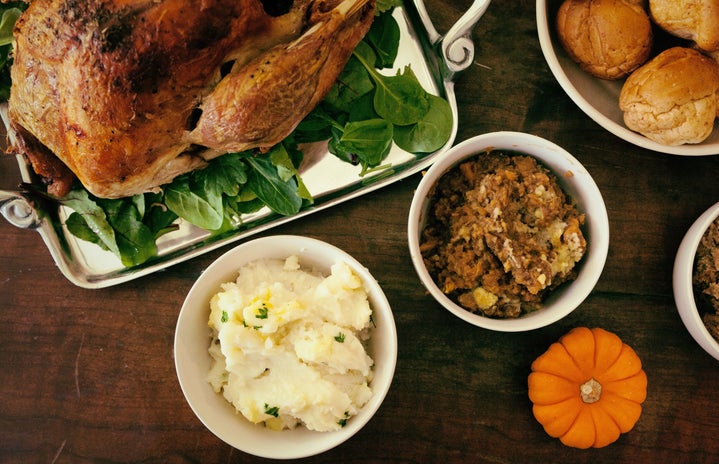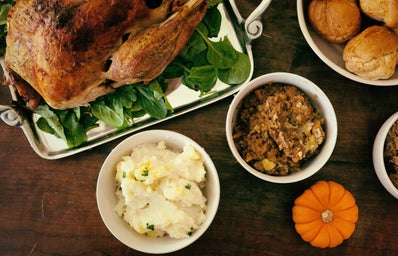As elementary school students, on the day before Thanksgiving break, many of us would celebrate the upcoming holiday with our classmates in a small recreation of the 1621 Thanksgiving feast. We used construction paper to make black hats with gold buckles or brown headbands with colored feathers, representing the pilgrims and the Native Americans. Then, we would end the day by drawing hand turkeys, and afterward, when we went home and showed them to our loved ones, Thanksgiving break officially began.
In elementary school and almost every year until high school, our teachers taught us that the pilgrims came to the United States in search of religious freedom on the Mayflower, but in their first year in the New World, they struggled immensely. As a result, the Native Americans–specifically the Wampanoag Nation–helped them survive by teaching them how to farm, hunt and fish with the help of their translator, Squanto.
Except, that isn’t really how it went.
In reality, the real events that led up to the 1621 feast and the consequences that followed are a dark history shrouded in pain and bloodshed. Because many schools teach Native American history very vaguely and without sufficient Native American narratives, the general public does not know their side of the story. Instead, we accept the generalized, Euro-centric and fabricated Thanksgiving tale.
We are quickly approaching Thanksgiving Day, and November is Native American Heritage Month. Although I am not Native American, I want to help ensure that their long and painful history is not forgotten or overshadowed by a romanticized myth. That said, here are a few facts about the real history behind Thanksgiving that we should know.
- No, Squanto did not just magically know English
-
As kids learning about the Pilgrims’ journey to the New World and their struggle once they arrived, our teachers taught us about the Native American man named Squanto, who acted as a translator between the Native Americans and the pilgrims. With Squanto and the Native Americans’ help, the pilgrims learned how to survive on this new land.
Although part of that story is true, it’s not the whole truth. When you’re a kid, you likely learned that Squanto–actually known as Tisquantum–knew English and acted as the bridge between the Native Americans, specifically the Wampanoag, and the pilgrims. However, your teachers probably left out how Tisquantum learned English. Personally, as a kid, I thought that he just learned it through the Wampanoag’s previous encounters with Europeans. However, there is much more to Tisquantum’s story, and I doubt any of your teachers told you about it. I know mine didn’t.
In 1614, European slave traders captured Tisquantum and several other Native Americans to sell them as slaves in Europe. Once sold as a slave, he spent some time in Spain before moving to England for several years, where he learned English. Then, in 1619, he returned to the New World only to discover that his entire tribe, the Patuxet, a band of the Wampanoag confederation, died because of a smallpox epidemic. Tisquantum was one of the last–if not the last–of his tribe. Later, in March of 1621, he met the pilgrims who settled on his tribe’s former land, and he began his relationship with them as the translator between the Wampanoag and the Englishmen.
- The Wampanoag did not help the Pilgrims out of the kindness of their hearts
-
When we first learned about the Wampanoag helping the pilgrims survive in the New World, we imagined that the Native Americans genuinely wanted to help them. Unfortunately, that isn’t the case.
Because the Wampanoag already had previous encounters with European colonizers, they knew of the strength–specifically, the weapons–that they brought. As a result, Wampanoag chief Ousamequin, otherwise known as Massasoit, formed somewhat of a partnership with the new settlers in 1621. One of the main reasons why he wanted to pursue this relationship was for protection against their enemies, which included the Narragansetts. However, many members of his tribe disagreed with the partnership, and some even wanted to ally with the Narragansetts to drive out the European settlers. Others believed that they caused the disease that wiped out a substantial amount of the Native American population in the area. Some even foretold prophecies that proclaimed that these new colonizers would be the end of their people. Sadly, they were correct.
- The 1621 Thanksgiving Feast was not technically the First Thanksgiving
-
Although little is known about the 1621 feast, it was not officially declared the First Thanksgiving. In reality, the First Thanksgiving occurred in 1637 following the Pequot Massacre.
On June 5, 1637, the English settlers, accompanied by the Mohegans and the Narragansett, surrounded the two-acre Pequot village, and began firing their guns through the cracks in the fort. However, they thought the gunfire was ineffective against the Pequot, so they resorted to burning them alive. Ultimately, over 400 Pequot men, women and children died in less than an hour. Later, when the Englishmen returned, the governor of the Massachusetts’s Bay Colony, John Winthrop, threw a Thanksgiving feast in honor of the men behind the massacre.
- The alliance between the Wampanoag and the settlers did not last long
-
Like many alliances, the relationship between the Wampanoag and the settlers did not even last a century. At the time when Massasoit’s second son Metacomet, also known as King Philip to the English, was the Wampanoag sachem, a devastating war began that left much of the Native American populations in New England in shambles. In our high school history classes, many of us learned that Metacomet’s War was one of the largest and one of the last Native American uprisings against European colonizers, but, if you’re like me, you didn’t learn much else about the event.
Metacomet’s War began when the European settlers executed some of his tribesmen for the murder of a Pukapoag interpreter and the Christian convert John Sassamon. As a result, the Wampanoag held a series of raids, and the New England Confederation of Colonies declared war on the Native Americans in 1675. The conflict lasted for three years and ultimately ended with Metacomet’s death when he was shot and killed in battle.
(TW: slight description of gore)
However, what the European settlers did with his body afterward is even more appalling and horrific. After Metacomet died, the settlers beheaded and dismembered his lifeless body and impaled his head on a spike that they displayed in Plymouth for 25 years. After his death, the settlers killed many of his remaining allies or sold them into slavery. Rough accounts detail that approximately 30% of the English population died in the conflict, and about 50% of the New England Native American population perished.
- For many Native Americans, Thanksgiving Day is the National Day of Mourning
-
For many Americans, Thanksgiving is a day of gratitude and family. However, for many Native Americans, it is a solemn reminder of Native American genocide, the theft of their land and an assault on their culture. For many of them, Thanksgiving Day is the National Day of Mourning.
The National Day of Mourning began in 1970 when organizers of the annual Thanksgiving banquet in Plymouth, Massachusetts, prevented Wamsutta (Frank B.) James, a Wampanoag man, from giving his speech because it did not fit their Thanksgiving beliefs. When the news reached the Moccasin Telegraph, hundreds of Native Americans came to Plymouth in solidarity, and James declared that day the National Day of Mourning.
The National Day of Mourning is a day of remembrance in which Native Americans honor their ancestors and remember the struggles of their people. Many will fast from sundown to the next afternoon, and they will hold a social after the mourning to break their fast. Although it is a Native-focused event, organizers of the National Day of Mourning welcome non-Native supporters and allies to the event.
As an idea, Thanksgiving is a beautiful day for family and loved ones to come together and be thankful, and I am not telling you that you should stop celebrating the holiday. I just hope that this article helps you acknowledge the history behind the holiday and realize that there is always more than one side to history.



